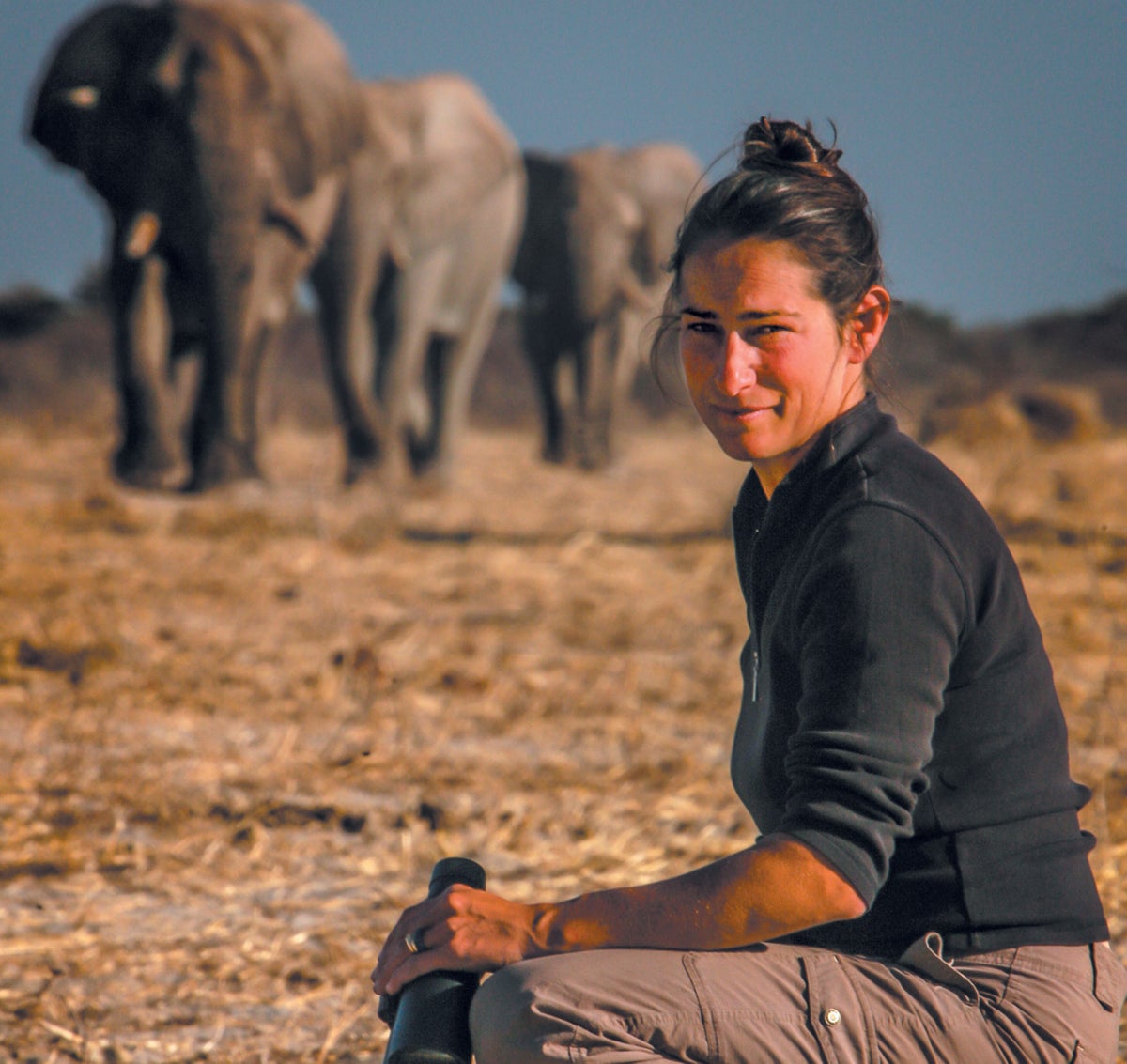Contributors to Scientific American’s May 2025 Issue
Writers, artists, photographers and researchers share the stories behind the stories
Caitlin O’Connell.
Caitlin O’Connell
Secrets of the Pachyderm Boys Club
Caitlin O’Connell (above) still gets emotional when she remembers her first encounter with an elephant. When a bull stepped in front of her vehicle in South Africa’s Kruger National Park, she looked up into the face of what felt like an old man. “This person has lived for so long, and what is his experience?” she thought. As a scientist studying elephant communication, she sees many parallels between these animals and humans. For example, “some young bulls will follow an older buddy and feed them” when they’re too old to eat on their own, she says. “This is part of what I want to get across: it’s so important for the young bulls to have these mentors,” she says of her article in this issue. “It makes an inordinate difference to their whole population.”
O’Connell first studied plant hopper insects, which communicate through sound waves that travel through plant stems or leaves. Then, while working at a national park in Namibia during a gap year after her master’s program, she noticed elephants might be doing something similar. It took a decade to prove that elephants communicate with seismic rumbles, and now more sophisticated tools are allowing scientists to start decoding their meaning. Researchers have revealed that elephants are using something akin to vowels and even calling one another by name. “We’re really at the forefront of some breakthroughs here.”
If you’re enjoying this article, consider supporting our award-winning journalism by subscribing. By purchasing a subscription you are helping to ensure the future of impactful stories about the discoveries and ideas shaping our world today.
Mark Belan
Graphic Science
Mark Belan wants to make science sexy. “It’s kind of tongue-in-cheek,” he says, but this goal nonetheless guides his work as a scientific illustrator. Science, he thinks, has acquired a reputation for being dense and dull, but to him it’s “the greatest story ever told.” As a graphics journalist, Belan aims to translate that wonder into eye-catching visuals that inspire people to appreciate sea slugs and ant colonies and other overlooked natural phenomena.
For this issue’s Graphic Science, written by Scientific American senior editor Clara Moskowitz, Belan charted the lifespans of some of Earth’s most incredible creatures, from fleeting worms to 15,000-year-old sea sponges. His graphic, which has a playful, toylike quality, invites readers into a 3D space alongside the data.
Willem Marx
Deep-Sea Mining Begins
For London-based journalist Willem Marx, the circumstances around his feature on deep-sea mining were doubly unusual. First, “it rarely happens that the industry at the center of controversy says [to a journalist], ‘Come and have a look,’” he says. Yet that’s precisely what happened: Marx visited the MV Coco off the coast of Papua New Guinea to observe some of the first commercial deep-sea mining operations. Second, when Marx asked residents for their perspectives on the mining, it turned out they were learning about it for the first time—which made Marx’s role part of the story. This was “a bit unnerving” for a journalist accustomed to being a mere observer, he says.
Marx travels often for assignments—when we spoke over the phone for this interview, he was reporting in Rome on the pope’s health. His time onboard the Coco was far from his first work trip at sea; in fact, he’d visited the very same ship while writing about the recovery mission for the Titan submersible, which imploded on its way to visit the Titanic wreckage.
This stint on the Coco came with an unusual requirement: a three-day safety course that involved plunging upside down into a pool in a mock helicopter, then breaking the helicopter window to swim out. “That’s a pretty intense requirement for a story outside of a combat zone, as far as I’m concerned.”
Hannah Nordhaus
A New Threat to Honeybees
In 2006 worker bees in hives across the U.S. began disappearing. The causes of this devastating phenomenon, called colony collapse disorder, remain largely a mystery, says journalist Hannah Nordhaus, who covered this event in her 2011 book, The Beekeeper’s Lament (Harper Perennial). But the epidemic probably had something to do with varroa mites—tiny parasites the industry had been battling for years. As Nordhaus writes in her feature for this issue, there will soon be a new, more deadly mite in town. Tropilaelaps, or tropi, mites “add another element of precarity” to the already risky beekeeping industry on which so many crops depend, she explains. Like this story, “all my bee stories have started with people,” Nordhaus says. This article begins with Sammy Ramsey of the University of Colorado Boulder, who is sounding the alarm on tropi mites.
Nordhaus, who lives in Boulder, was raised in Washington, D.C., in a family involved in politics and environmentalism. Her roots, though, are farther west. Her second book, American Ghost (HarperCollins, 2015), tells the story of her great-great-grandmother, whose ghost was said to haunt a hotel in Santa Fe, N.M. As soon as Nordhaus had the opportunity, she moved out west, where her passions for history and the environment are both engaged. “In any history of the American West, there’s always an environmental strand that weaves through it.”
Allison Parshall is an associate news editor at Scientific American who often covers biology, health, technology and physics. She edits the magazine’s Contributors column and weekly online Science Quizzes. As a multimedia journalist, Parshall contributes to Scientific American‘s podcast Science Quickly. Her work includes a three-part miniseries on music-making artificial intelligence. Her work has also appeared in Quanta Magazine and Inverse. Parshall graduated from New York University’s Arthur L. Carter Journalism Institute with a master’s degree in science, health and environmental reporting. She has a bachelor’s degree in psychology from Georgetown University. Follow Parshall on X (formerly Twitter) @parshallison
Source: www.scientificamerican.com
